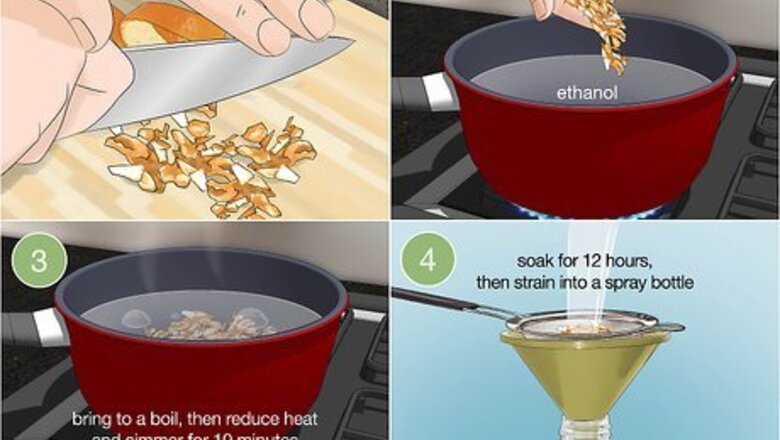
views
Here are 11 natural ways to keep silverfish away from all of your books.
Make a citrus peel spray to drive off silverfish.
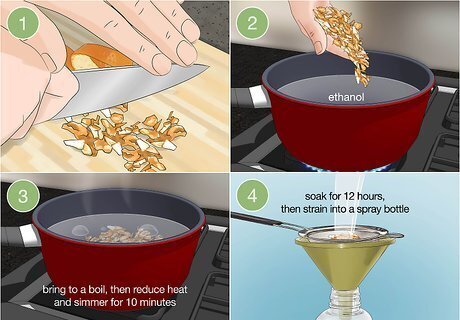
Soak chopped-up peel in warm alcohol overnight. To make a citrus spray insecticide, roughly chop the peel from at least a couple of oranges, lemons, or other citrus fruit. Put these into a pot along with enough ethanol (or other alcohol) to cover them. Bring to a boil, then reduce heat and simmer for 10 minutes. Let the mixture soak for 12 hours, then strain into a spray bottle. Spray onto silverfish when you see them, or onto the areas around your bookshelves to make them less appealing to the insects. Any form of high-proof alcohol can extract a natural chemical called limonene from the peel. You can try using water instead, but it extracts limonene much less effectively. Limonene (at high enough concentration) is proven to kill silverfish. Oranges or mandarins are good choices, but just about any citrus fruit peel contains lots of limonene. This recipe isn't hard science. The more peel you use and the longer you soak it, the stronger your spray will be, but feel free to experiment.
Repel silverfish with herbs.

Mint and thyme are your best bets, but others might work. Try drying sprigs of herbs to keep next to or behind your books, bruising them a little to help them release their scent. Mint and thyme both contain lots of limonene, while sage, hyssop, rosemary, and fennel have some (though much less). Limonene is dangerous for silverfish to contact, so the goal is to release enough of it that they see your bookshelves as a danger zone. Not all mint is created equal. Fortunately, spearmint is quite high in limonene, while "mountain mint" is even better if you can find it. If your local grocery store just sells "mint" with no other description, that's probably spearmint (at least in the US). Until some scientists start to focus on this vital course of research, it's hard to say exactly how many herbs you need. The more concentrated the better, so bunch them up wherever you see the most damage. Replace the herbs once they dry out.
Deter the silverfish with essential oils.
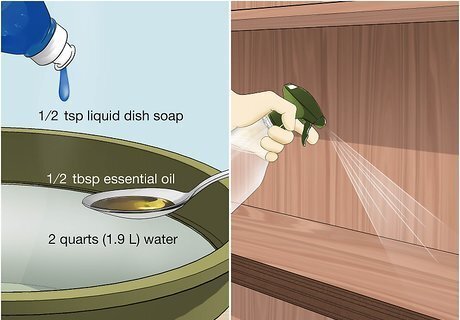
Strong options include oils of lemon peel, celery, and mint. A pure essential oil (not diluted with a carrier oil) can be an extremely concentrated delivery system for substances that silverfish hate. While wearing gloves, place a few drops of essential oil onto the ends of shelves, wall crevices, and anywhere you see silvery dust. To make an insecticide spray that covers larger areas and is safer for children and pets, instead mix ⁄2 tablespoon (7.4 ml) essential oil, ⁄2 teaspoon (2.5 ml) liquid dish soap, and 2 quarts (1.9 L) water, and shake well in a spray bottle. Essential oils may be natural, but they're also dangerous when they're not diluted. If you get it on your bare skin, wipe it off with vegetable oil to prevent a burn or allergic reaction. Don't use them on bookshelves that children or pets can access. Mint oil is a proven insecticide against silverfish. Lemon peel oil and celery seed (or "celery fruit") oil both contain extremely high concentrations of limonene, a known silverfish insecticide. (Check the details before you buy: essential oil from celery root is about seven times weaker.) Neem oil is okay, but weaker than mint. Cinnamon, cloves, and lavender are all traditional silverfish repellents, but there's not a lot of evidence behind them. (Then again, most agricultural scientists are busy studying pests that eat grapes and not Grapes of Wrath.) It's best not to use a diffuser as a permanent insect repeller. Being around a diffuser for more than an hour can cause headaches and other unpleasant symptoms.
Make simple glass traps to lure the insects somewhere else.
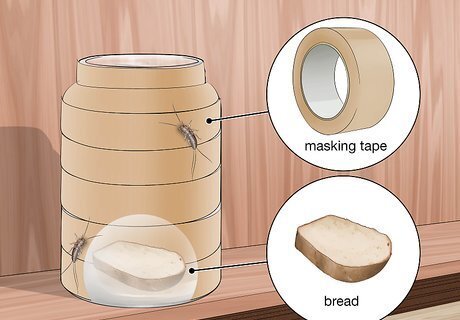
Bait the trap and give the insects something to climb. At least you can be thankful for one thing: silverfish aren't the smartest. Drop a piece of bread into a glass jar, and they'll happily fall in to eat it and get stuck. Help them get to the top by wrapping the outside of the jar in masking tape (which they can climb). Place the jars around your bookshelves to distract and trap silverfish before they get to the paper. Instead of the masking tape, you can tape the short edge of an index card securely to the top of the jar. Arrange the card so the other end touches the ground, forming a ramp the silverfish can climb up.
Divert the silverfish into damp newspaper.

Moist rolls of newspaper are a quick, effective lure. A damp newspaper, rolled up and held together loosely by a rubber band, is very attractive to silverfish as a food source and resting place. Pick it up every two to four days (without opening it), take it outside to the trash, and replace it with a new one. This is probably going to catch more silverfish than a glass jar would, but of course you might not want to live with wet newspaper in your living room.
Sprinkle natural dust insecticides.
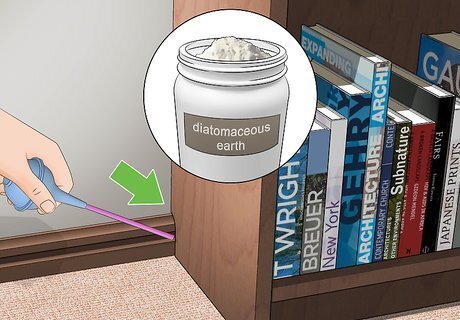
Diatomaceous earth, silica gel, and boric acid can all kill silverfish. Use a bulb duster or a plastic squeeze bottle to blow one of these fine dusts into cracks and crevices around your bookshelves. Unfortunately, without a synthetic insecticide mixed in, they are unlikely to end the infestation. That said, they will still hurt or kill the silverfish that touch it directly. Careful—diatomaceous earth and silica gel are forms of fine sand that can irritate your lungs and skin somewhat. Boric acid can be dangerous for infants and pets. These all occur in nature, but the last two can also be factory-produced, so it's up to you whether you consider this natural enough. Read the label and safety instructions very carefully, as these products can have other added insecticides. This is sometimes "pyrethrin," a natural (but still toxic) pesticide from chrysanthemums. However, many other similar-sounding ingredients like "synergized pyrethrin" or "pyrethroid" are synthetic.
Rearrange your bookshelves regularly.

Check stacks of magazines and loose papers especially. These are places where silverfish might hide or return often to feed. Until the infestation is gone, rearrange your shelves once in a while to disrupt their habits. This also helps you keep tabs on where they're active so you know where to focus your efforts.
Vacuum regularly.

Vacuuming crevices gets rid of silverfish food storage and eggs. Vacuuming under furniture and around the corners of the room can help keep the silverfish population down. A flexible crevice tool attachment for your vacuum cleaner will help you get at the smallest cracks in the wall.
Seal up crevices.

Blocking entryways is a better long-term solution than repellents. Silverfish often get in through cracks around your molding, window panes, or places where pipes go through walls. Sealing these with caulk, plaster, or putty (the kinds you find at a hardware store) can go a long way toward solving the problem.
Dry out humid rooms to keep the long-term population down.

Ventilate closed spaces where silverfish breed. Silverfish need warm, damp places to mate, like basements, laundry rooms, and bathrooms. Keeping windows open and running fans in these spaces can make this harder, so they reproduce less..ref>http://ipm.ucanr.edu/PMG/PESTNOTES/pn7475.html For moist rooms with no windows, try to remove the source of moisture (by repairing leaky pipes, for instance), or run a dehumidifier if that's not feasible. Note that the adults can still survive for up to three years. Use deterrents and traps to help protect your books immediately. Try this method alongside them as an investment in your future, to make the infestation less of a problem down the line.
Protect important books with cedar.

Cedar wood shavings or a cedar box can deter silverfish. Cedar is a traditional insect repellent—it won't kill the silverfish, but the smell might keep them away. A cedar box is a pretty way to protect your most sentimental books and papers, even if it's a bit impractical for a whole library. Cedar probably works because it contains limonene, a chemical that can kill silverfish when it's more concentrated. A lot of coniferous trees (trees with needle-like leaves) also release at least a little of this, so you could experiment with their leaves or bark if they grow nearby.



















Comments
0 comment